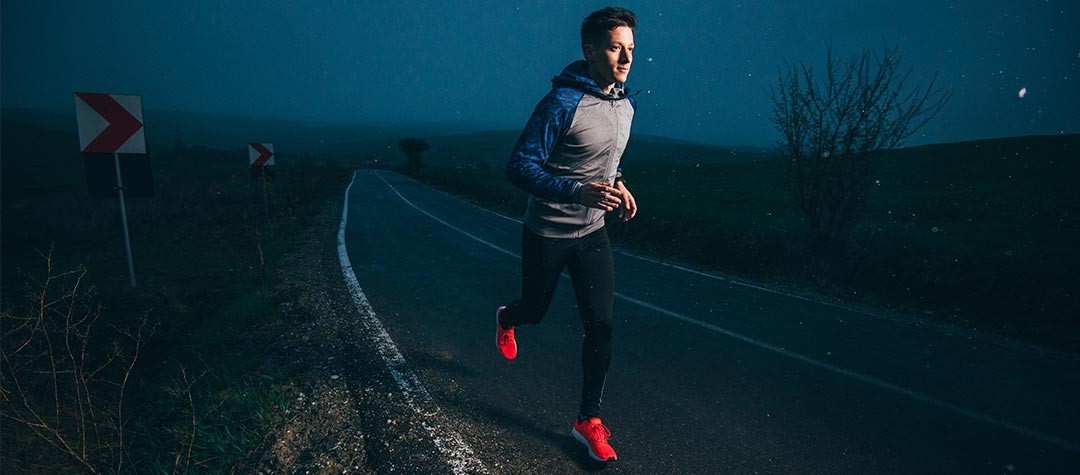By altering your training you can get the most out of run sessions in the dark and ensure you make good progress in often limited time.
Dark nights (and mornings for that matter) can be a pain, and the prospect of going out on a run in the dark, especially alone, can seem pretty unappealing at times. However, once you get yourself up and out, running in the dark is not as bad as anticipated and it helps you find that time that you need to run.
Run with others
As with the any kind of training, it is always more bearable if there is someone else to train with. If this means getting yourself along to a club and meeting up with other runners, then you should do this. Not only is this great for your motivation and commitment levels, there is also the added safety bonus of not running alone.
Run faster but shorter
To make the most of running sessions in the dark, you may have to alter your training slightly. A simple way of doing this is to cut back on your distance but instead pick up the pace. Put simply, running 5 miles (8km) quickly will bring similar benefit to running ten miles slowly. Quality not quantity is what counts when running.
Here's some tips aimed beginner, intermediate, and more advanced runners to help maximise your benefits from short running sessions in the dark:
1. Beginner runners
Decrease the length of your run in actual time but try and make an effort to run at a faster pace. For example, instead of running 30 minutes slowly, try 20 minutes fast. It may feel more uncomfortable running fast but at least it’s over quicker. As you get fitter; try keeping the same pace but running for longer. This way you will see an improvement in your fitness over time.
2. Intermediate club athletes
On a 30 minute run, every five minutes try and pick up the pace so that by the end you are running quite hard. Gradually get faster throughout the run until the last five minutes feels uncomfortably hard. As your fitness levels go up, make the last uncomfortably hard part of your run longer. Eventually you should be able to run the whole 30 minutes at this uncomfortable hard (threshold) pace. 30 minutes is about the maximum that should be done when threshold running.
3. More experienced runners
Threshold running should be an integral part of your training by now. Try dropping to less than 30 minutes but running even faster than before. For example, 20 minutes at the new faster pace. Eventually move up to the 30 minutes again, but when you get there and feel comfortable again, drop down to 20 minutes again and run even faster. As you can see this is a never ending cycle but it works and definitely gets you fitter and faster.
Gear you need for running in the dark
If you are planning on making running in the dark or low light conditions a regular thing then check out these suggestions of gear you might just need to make your runs as safe as possible.
High-vis clothing
Dark clothing can make you hard to see for motorists, cyclists and even pedestrians, so wear bright clothing, and ideally items with reflective strips. Trainers, shorts, leggings, gilets, jackets, gilets are all available with high vis elements so go for those, especially if the bulk of your running is going to be in low light conditions.
Secure running belt or pouch
When running you want any items you are carrying, such as keys, to be secure. This is particularly important when running in the dark as if your key goes flying out of an unsecured pocket then you may not be able to find it again. A secure belt or pouch guards against this scenario.
In addition to keys, you could also safely stash a mobile phone, some emergency cash, and any nutritional items you need for your run in your secure belt. It would also be prudent to include some identification, such as an ID tag, should anything major occur when you are out on your run.
High vis accessories
As well as your clothing there are also an array of accessories that you can add to improve your visibility when on a run. Reflective bands and lights which can be attached to different parts of the body can massively improve awareness of you by other people when on a low light run.
If you are planning in running in areas with very little street lighting then a headtorch will help you see as well as being seen. This will help you avoid all those potholes, uneven running surfaces, and other trip hazards.
GPS or fitness tracker
If running in the dark, navigating your way on your run can be more tricky, unless you are well acquainted with your surroundings. A GPS watch of other fitness can be ideal, especially if you are looking for some turn-by-turn directions.
Not only will your device track your performance, but many also have the option to download music to your device to help keep you motivated when you run. Ideally, couple this with some bone-conducting headphones that still allow you to hear your surroundings.
Personal safety alarm
As a final safety step, especially if you are a solo runner, you may want to consider carrying a personal safety alarm. One of these will shock and disorientate an attacker giving you time to make your escape. Make sure you have quick and easy access to your alarm so you are not fumbling around for it when you need it most.














